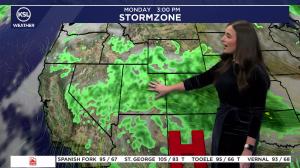Estimated read time: 2-3 minutes
- Utah's reservoirs are 88% full, with no flooding threat despite early snowmelt.
- Northern Utah's snow water equivalent is normal, but southern regions face dire conditions.
- Experts urge conservation as warm weather approaches, impacting future water availability.
SALT LAKE CITY — Much of Utah got through this last water year with near normal conditions for snowfall and precipitation, but there was an early melt of snow at lower and mid-level elevations, which will bring a runoff in the coming months with little threat of flooding.
At Thursday's Water Supply Outlook meeting, bringing together water experts, reservoir managers and other water providers, presenters detailed the water year and what is expected in the coming months.
The snow accumulation season peaked on March 23 — a bit early — logging 14.3 inches of snow water equivalent the state gained on average.
If anything is to be said about conditions in the north, it is they are normal — not stellar, not dismal — just normal.
The Weber-Ogden basin logged 100% of snow water equivalent as of April 9, the Bear sits at 104%, while Provo-Utah Lake is 106%.
A dreary, dry year
The farther south you get the more the story changes.
Glen Merrill, senior service hydrologist with the National Weather Service in Salt Lake City, said while March brought near-normal precipitation to southwest Utah, it did not make up for how the rest of the water year treated the region.
It sits at 42% of snow water equivalent, while the Escalante-Paria Basin is at 34% and southeastern Utah comes in at a measly 34%.
That region described as "really dire," will have to dig out of the hole it has found itself in with more conservation and prayers for an active monsoon season this summer.
Soil moisture, too, for the entire state is at about 60% of average, which is a bit concerning though it does erase concerns for any high risk of flooding.
The good news
Gary Henrie, a civil engineer with the U.S. Bureau of Reclamation, said reservoir levels are in "really, really good shape."
Statewide, on average, reservoirs are 88% full. Weber Basin Water Conservancy District recently announced it was making some early releases to allow its system to absorb the incoming runoff.
Echo is nearly 91% full; East Canyon tops out at just above 89% full and Pineview and Willard Bay are in good shape hovering in the 90% levels. Starvation is full and even larger reservoirs like Strawberry and Jordanelle sit at 90% and 80%, respectively.
Those numbers spell hope for farmers and other irrigators, but agencies are warning water users to continue to practice conservation measures to see the state through the summer so it can bank some water for the coming snowpack accumulation season.
The next couple of days will see warmer than average weather, with temperatures 15 to 20 degrees above normal, Merrill said.
Saturday temperatures may drop by as much as 30 degrees as a waterless cold front skirts by, and it will be quite windy.
Next week, the temperatures will begin to climb above normal as a high-pressure system sets in.













